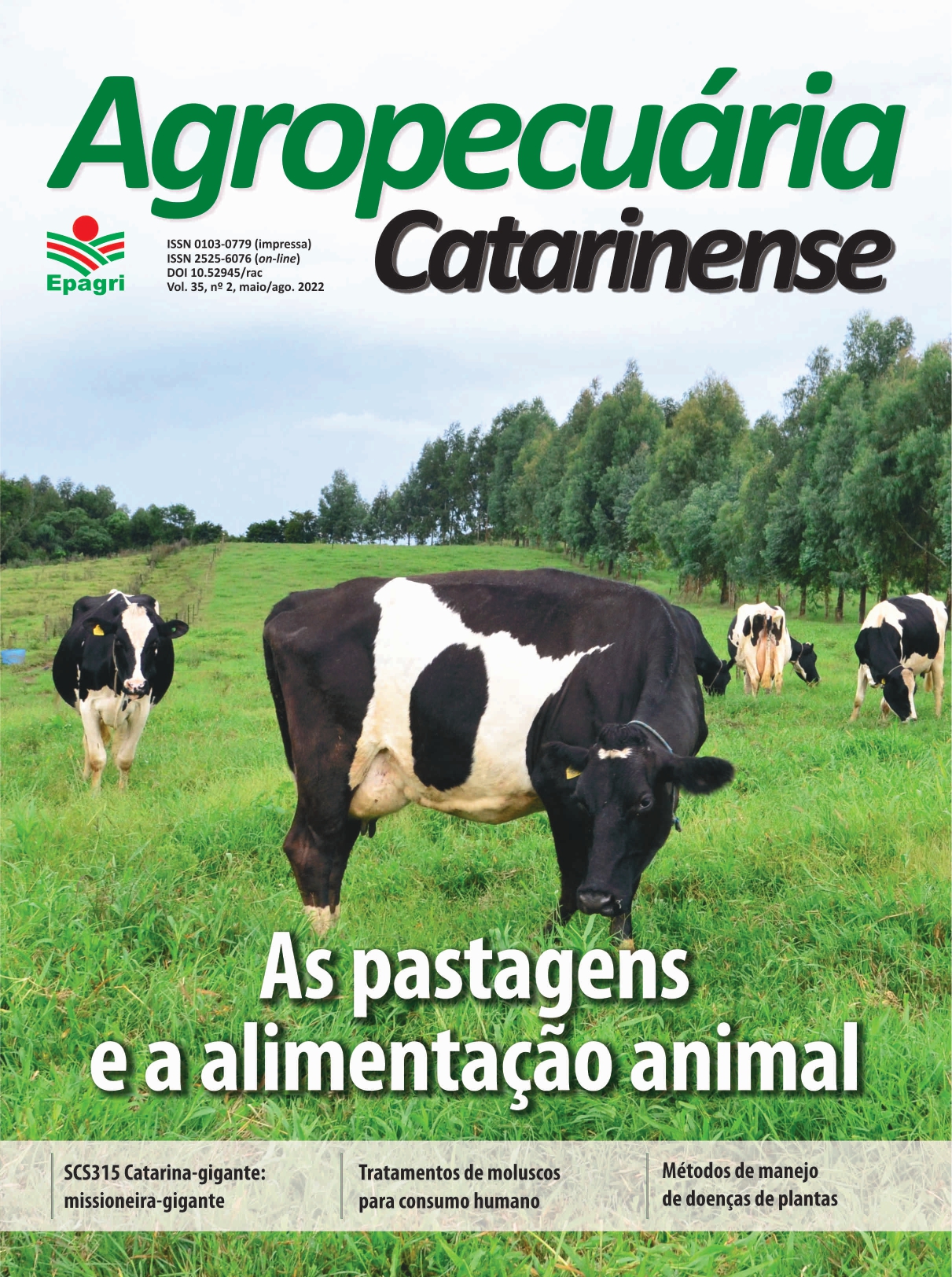Giberela e Desoxinivalenol: Qual a relação e como fungicidas podem ajudar?
DOI:
https://doi.org/10.52945/rac.v35i2.1469Palavras-chave:
DON, Fusarium graminearum, Micotoxinas, TrigoResumo
A Giberela, causada principalmente por Fusarium graminearum, é uma das doenças mais comuns em trigo. Além de causar reduções na produtividade da cultura, também é responsável pelo acúmulo de micotoxinas, especialmente a desoxinivalenol (DON), em grãos de trigo. Esse trabalho foi desenvolvido durante dois anos agrícolas buscando avaliar a utilização de diferentes cultivares, diferentes datas de plantio e diferentes manejos com fungicidas para aumentar a produtividade e a qualidade dos grãos (menor incidência de DON). O trabalho foi conduzido sob esquema de blocos casualizados. Fracas correlações entre a incidência de giberela, incidência de Fusarium nas sementes e DON foram observadas. O uso de fungicidas ajudou a aumentar a produtividade, o peso hectolitro e o peso de mil sementes do trigo, principalmente em 2019 (ano mais úmido). Os fungicidas são excelentes ferramentas para ajudar produtores a alcançar maiores produtividades, entretanto, seu uso deve ser realizado com cautela para não favorecer a biossíntese e acúmulo de micotoxinas em grãos de trigo.
Referências
BECK, H.E.; ZIMMERMANN, N.E.; MCVICAR, T.R.; VERGOPOLAN, N.; BERG, A.; WOOD, E.F. Present and future Köppen-Geiger climate classification maps at 1-km resolution. Scientific Data, v.5, 180214, 2018. DOI: https://doi.org/10.1038/sdata.2018.214.
BONFADA, E.B.; HONNEF, D.; FRIEDRICH, M.T.; BOLLER, W.; DEUNER, C.C. Performance of fungicides on the control of fusarium head blight (Triticum aestivum L.) and deoxynivalenol contamination in wheat grains. Summa Phytopathologica, v. 45, n. 4, p. 374–380, 2019. DOI: https://doi.org/10.1590/0100-5405/191941.
DRAZ, I.S.; ESMAIL, S.M.; ABOU-ZEID, M.A.E-H.; ESSA, T.A.E-M. Powdery mildew susceptibility of spring wheat cultivars as a major constraint on grain yield. Annals of Agricultural Sciences, v.64, n.1, p.39–45, 2019. DOI: https://doi.org/10.1016/j.aoas.2019.05.007.
DUCATTI, R.D.B.; WORDELL FILHO, J.A.; MAZARO, S. M. Deoxynivalenol biosynthesis and accumulation in wheat affected by carrageenan. Revista de Ciências Agroveterinárias, v.21, n.2, p.176–181, 2022. DOI: https://doi.org/10.5965/223811712122022176.
JI, F.; WU, J.; ZHAO, H.; XU, J.; SHI, J. Relationship pf deoxynivalenol content in grain, chaff, and straw with Fusarium head blight severity in wheat varieties with various levels of resistance. Toxins, v.7, p.728–742, 2015. DOI: https://doi.org/10.3390/toxins7030728.
LARGE, E.C. Growth stages in cereals illustration of the Feekes scale. Plant Pathology, v.3, n.4, p.128–129, 1954. DOI: https://doi.org/10.1111/j.1365-3059.1954.tb00716.x.
MARIN, S.; RAMOS, A.J.; CANO-SANCHO, G.; SANCHIS, V. Mycotoxins: Occurrence, toxicology, and exposure assessment. Food and Chemical Toxicology, v. 60, p. 218–237, 2013. DOI: https://doi.org/10.1016/j.fct.2013.07.047.
MCMULLEN, M.; BERGSTROM, G.; DE WOLF, E.; DILL-MACKY, R.; HERSHMAN, D.; SHANER, G.; VAN SANFORD, D. A Unified Effort to Fight and Enemy of Wheat and Barley: Fusarium Head Blight. Plant Disease, v. 96, n. 12, p. 1712–1728, 2012. DOI: https://doi.org/10.1094/PDIS-03-12-0291-FE.
MERHEJ, J.; BOUTIGNY, A.L.; PINSON-GADAIS, L.; RICHARD-FORGET, F.; BARREAU, C. Acidic pH as a determinant of TRI gene expression and trichothecene B biosynthesis in Fusarium graminearum. Food Additive & Contaminants – Part A, v. 27, p. 710–717, 2010. DOI: https://doi.org/10.1080/19440040903514531.
PINTON, P.; OSWALD, I.P. Effect of deoxynivalenol and other type B trichothecenes on the intestine: a review. Toxins, v.6, n.5, p.1615–1643, 2014. DOI: https://doi.org/10.3390/toxins6051615.
PONTE, E.M.D.; GARDA-BUFFON, J.; BADIALE-FURLONG, E. Deoxynivalenol and nivalenol in commercial wheat grain related to Fusarium Head Blight epidemics in southern Brazil. Food Chemistry, v.132, n.2, p.1087–1091, 2012. DOI: https://doi.org/10.1016/j.foodchem.2011.10.108.
PONTS, N. Mycotoxins are a component of Fusarium graminearum stress-response system. Frontiers in Microbiology, v.6, p.1–5, 2015. DOI: https:/doi.org/10.3389/fmicb.2015.01234.
RANDHAWA, M.S.; BHAVANI, S.; SINGH, P.K.; HUERTA-ESPINO, J.; SINGH, R.P. Disease Resistance in Wheat: Present Status and Future Prospects. In: WANI, S.H. (Ed.). Disease Resistance in Crop Plants. Switzerland: Springer, 2019. p. 61–81. DOI: https://doi.org/10.1007/978-3-030-20728-1_4.
REIS, E.M.; BOARETO, C.; DANELLI, A.L.D.; ZOLDAN, S.M. Anthesis, the infectious process and disease progress curves for fusarium head blight in wheat. Summa Phytopathologica, v. 42, n. 2, p. 134–139, 2016. DOI: https://doi.org/10.1590/0100-5405/2075.
STACK, R.W.; MCMULLEN, M.P. A visual scale to estimate severity of Fusarium head blight in wheat. NDSU Extension Service. North Dakota State University, 2011.
WEGULO, S.N. Factors Influencing Deoxynivalenol Accumulation in Small Grain Cereals. Toxins, v.4, n.11, p.1157–1180, 2012. DOI: https://doi.org/10.3390/toxins4111157.
Downloads
Publicado
Edição
Seção
Licença
Copyright (c) 2022 João Américo Wordell Filho, Rafael Dal Bosco Ducatti, Cristiano Nunes Nesi

Este trabalho está licenciado sob uma licença Creative Commons Attribution 4.0 International License.






